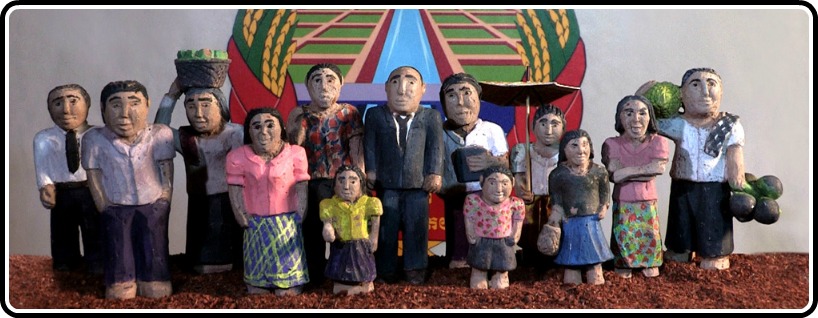While it may not be the most financially viable or most publicity-finding section of the cinematic landscape, non-fiction cinema has become one of the most forward thinking and medium-pushing segments of the film world, with new film after new film attempting to tell real, raw stories in ways ranging from voice over led diary readings (Teenage) to surreal meditations on the absurdity of violence (The Act Of Killing). Toss in purely visceral, wholly cinematic pictures like Leviathan and we are currently stuck in the middle of what may go down as the golden age of the documentary film.
And that trend doesn’t appear to be stopping anytime soon.
One of today’s most interesting documentary filmmakers is back with what may be his most astonishing works to date, as Rithy Panh’s latest film, The Missing Picture, has finally left the festival circuit behind and is now available to see in limited release.
Often described as a Southeast Asia response to a filmmaker like Claude Lanzmann, Panh’s newest film once again deals with the horrors of genocide, this time in a deeply personal and firmly autobiographical way. Following up his last feature, the under seen masterpiece Duch, Master Of The Forges Of Hell, the director is back with a stunning autobiographical account of the horrors seen during the rule of the Khmer Rouge and it’s head figure, Pol Pot. A subject Panh has been interested in mining for much of his entire career, this film delves a bit more personal, as it takes a look at a span in Panh’s own life. Looking specifically at his teenage years, this film mixes unmistakably personal self portrait with breathless aesthetic experimentation into what is easily one of the most visually inspired documentaries, and also one of the most emotionally resonant, in ages.
Forced out of he and his family’s home in Phnom Penh, the capital of his native Cambodia, we find Panh, his life and his homeland just at the brink of absolute chaos. Turning from a relatively vital member of the Asian world into a place where proper names were exchanged for simple numbers, Cambodia during this time period is one of complete revolution and chaos, a Marxist failure of the highest (or should I say lowest) order. With no outside culture allowed to enter the country, and ostensibly just Khmer Rouge propaganda films being the only real filmed footage shot during this time period, The Missing Picture is both a triumph of documentary storytelling, and also an important piece of Cambodian culture, highlighting a point in time in the nation’s history where it was all but blacked out to the entire world.
And the beauty of this picture is the breathless nature with which Panh paints this harrowing portrait. Blending source footage, newly shot stock footage and, most interesting, detailed diorama sequences using hand made figures attempting to re-enact moments in the life of those living under this regime. These sequences are likely going to be this Oscar-nominated picture’s most talked about aspect, but it is truly for good reason. These moments, in all of their inherent aesthetic playfulness and odd innocence really bring to light the damning horrors brought on by this regime, a regime that ultimately tried to wipe out an entire section of world culture.
Hence why these sequences are both aesthetically appealing and also inherently needed in telling this story. As we discover, the film’s title isn’t just for kicks and grins, but a true telling statement of life under this rule. As there is little to no documentary footage of life under the Khmer Rouge, these sequences play as truly the closest thing we, the viewing audience, will ever get to seeing what this life was like. As hinted at by the film’s final coda, this picture is both intended to be cathartic for a director whose entire career has been driven by the need to tell this type of story (ostensibly Panh’s career, much like Lanzmann’s, has been filled by attempts to reach at the ultimate nature of genocide, in all of its forms) as well as a historical document portraying life under the Khmer Rouge, a rule that saw Cambodian culture nearly wiped off the sociological map. One could argue the film as being slightly crude, but this rough, enveloping and emotionally raw motion picture is one of the most important and emotionally devastating motion pictures to hit theaters in what is now shaping up to be a hell of a 2014. Definitively a filmed memoir, Panh’s picture is one of breathing vitality, a picture so unflinching and utterly enthralling that to be able to shake this film after seeing it is to be completely void of a human soul. Too bad Oscar didn’t call its name earlier this March, because this is truly one of the best, and most important, documentaries to arrive in years.




![Bergman Island (The Criterion Collection) [Blu-ray]](https://criterioncast.com/wp-content/uploads/2022/11/bergman-island-the-criterion-collection-blu-ray-400x496.jpg)
![This Is Not a Burial, It’s a Resurrection (The Criterion Collection) [Blu-ray]](https://criterioncast.com/wp-content/uploads/2022/11/this-is-not-a-burial-its-a-resurrection-the-criterion-collection-blu-ray-400x496.jpg)
![Lars von Trier's Europe Trilogy (The Criterion Collection) [The Element of Crime/Epidemic/Europa] [Blu-ray]](https://criterioncast.com/wp-content/uploads/2022/11/lars-von-triers-europe-trilogy-the-criterion-collection-the-element-of-400x496.jpg)
![Imitation of Life (The Criterion Collection) [Blu-ray]](https://criterioncast.com/wp-content/uploads/2022/11/imitation-of-life-the-criterion-collection-blu-ray-400x496.jpg)
![The Adventures of Baron Munchausen (The Criterion Collection) [4K UHD]](https://criterioncast.com/wp-content/uploads/2022/11/the-adventures-of-baron-munchausen-the-criterion-collection-4k-uhd-400x496.jpg)
![Cooley High [Criterion Collection] [Blu-ray] [1975]](https://criterioncast.com/wp-content/uploads/2022/11/cooley-high-criterion-collection-blu-ray-1975-400x496.jpg)